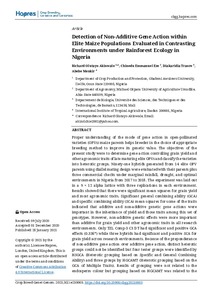| dc.contributor.author | Akinwale, R.O. |
| dc.contributor.author | Eze, C.E. |
| dc.contributor.author | Traore, D. |
| dc.contributor.author | Menkir, A. |
| dc.date.accessioned | 2021-04-28T12:15:10Z |
| dc.date.available | 2021-04-28T12:15:10Z |
| dc.date.issued | 2021 |
| dc.identifier.citation | Akinwale, R.O., Eze, C.E., Traore, D. & Menkir, A. (2021). Detection of non-additive gene action within elite maize populations evaluated in contrasting environments under rainforest ecology in Nigeria. Crop Breeding, Genetics and Genomics, 3(1):e210003, 1-24. |
| dc.identifier.issn | 2632-7309 |
| dc.identifier.uri | https://hdl.handle.net/20.500.12478/7110 |
| dc.description.abstract | Proper understanding of the mode of gene action in open-pollinated varieties (OPVs) maize parents helps breeder in the choice of appropriate breeding method to improve its genetic value. The objectives of the present study were to determine gene action controlling grain yield and other agronomic traits of late maturing elite OPVs and classify the varieties into heterotic groups. Ninety-one hybrids generated from 14 elite OPV parents using diallel mating design were evaluated with their parents plus three commercial checks under marginal rainfall, drought, and optimal environments in Nigeria from 2017 to 2018. The experiment was laid out in a 9 × 12 alpha lattice with three replications in each environment. Results showed that there were significant mean squares for grain yield and most agronomic traits. Significant general combining ability (GCA) and specific combining ability (SCA) mean squares for some of the traits indicated that additive and non-additive genetic gene actions were important in the inheritance of yield and those traits among this set of genotypes. However, non-additive genetic effects were more important than additive for grain yield and other agronomic traits in all research environments. Only TZL Comp-3 C3 DT had significant and positive GCA effects (0.336*) while three hybrids had significant and positive SCA for grain yield across research environments. Because of the preponderance of non-additive gene action over additive gene action, distinct heterotic groups could not be identified but four tester groups were identified by HSGCA (Heterotic grouping based on Specific and General Combining Ability) and three groups by HGCAMT (Heterotic grouping based on the GCA of Multiple Traits). Results of grouping were not related to the endosperm colour but grouping based on HGCAMT was related to the pedigree of the varieties. In conclusion, this study has demonstrated preponderance of non-additive gene action over the additive gene action for all measured traits. The presence of the non-additive gene action present in the studied materials can enhance identification of outstanding varietal hybrids and population testers that can serve as base genetic materials for future maize improvement through reciprocal recurrent selection program in SSA. |
| dc.description.sponsorship | German Federal Ministry of Education |
| dc.description.sponsorship | Ernst Mach Grant |
| dc.description.sponsorship | Austrian agency for International Mobility and Cooperation in Education, Science and Research |
| dc.format.extent | 1-24 |
| dc.language.iso | en |
| dc.subject | Combining Ability |
| dc.subject | Diallel Analysis |
| dc.subject | Maize |
| dc.subject | Pollination |
| dc.subject | Food Security |
| dc.subject | Nigeria |
| dc.title | Detection of non-additive gene action within elite maize populations evaluated in contrasting environments under rainforest ecology in Nigeria |
| dc.type | Journal Article |
| cg.contributor.crp | Maize |
| cg.contributor.affiliation | Obafemi Awolowo University |
| cg.contributor.affiliation | Michael Okpara University of Agriculture |
| cg.contributor.affiliation | Université des Sciences, des Techniques et des Technologies, de Bamako |
| cg.contributor.affiliation | International Institute of Tropical Agriculture |
| cg.coverage.region | Africa |
| cg.coverage.region | West Africa |
| cg.coverage.country | Nigeria |
| cg.coverage.hub | Headquarters and Western Africa Hub |
| cg.researchtheme | Biotech and Plant Breeding |
| cg.identifier.bibtexciteid | AKINWALE:2021 |
| cg.authorship.types | CGIAR and developing country institute |
| cg.iitasubject | Agronomy |
| cg.iitasubject | Food Security |
| cg.iitasubject | Maize |
| cg.iitasubject | Plant Breeding |
| cg.iitasubject | Plant Production |
| cg.journal | Crop Breeding, Genetics and Genomics |
| cg.notes | Open Access Journal; Published online: 28 Jan 2021 |
| cg.accessibilitystatus | Open Access |
| cg.reviewstatus | Peer Review |
| cg.usagerightslicense | Creative Commons Attribution 4.0 (CC BY 0.0) |
| cg.targetaudience | Scientists |
| cg.identifier.doi | https://dx.doi.org/10.20900/cbgg20210003 |
| cg.iitaauthor.identifier | Abebe Menkir: 0000-0002-5907-9177 |
| cg.futureupdate.required | No |
| cg.identifier.issue | 1: e210003 |
| cg.identifier.volume | 3 |
| cg.contributor.acknowledgements | The authors extend their gratitude to Dr. Baffour Badu-Apraku (IITA, Ibadan) for the provision of pollination bags used for the crosses. The authors also appreciate the contributions of Dr. Sebastian Michel and Professor Hermann Bürstmayr of the Department of Agrobiotechnology, Institute of Biotechnology in Plant Production Tulln, Austria, for their technical support in the latter phase of the work. |

